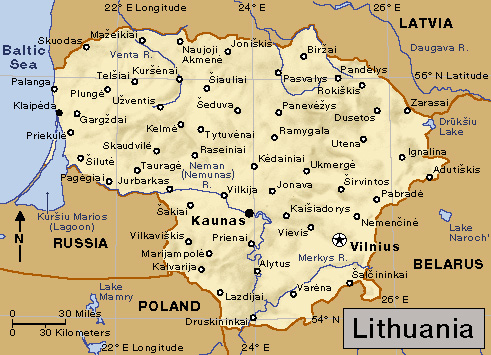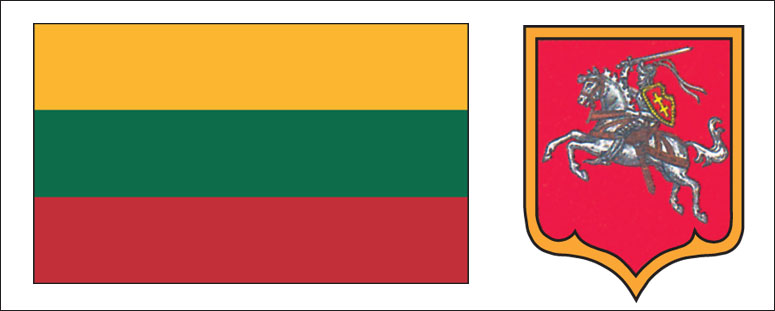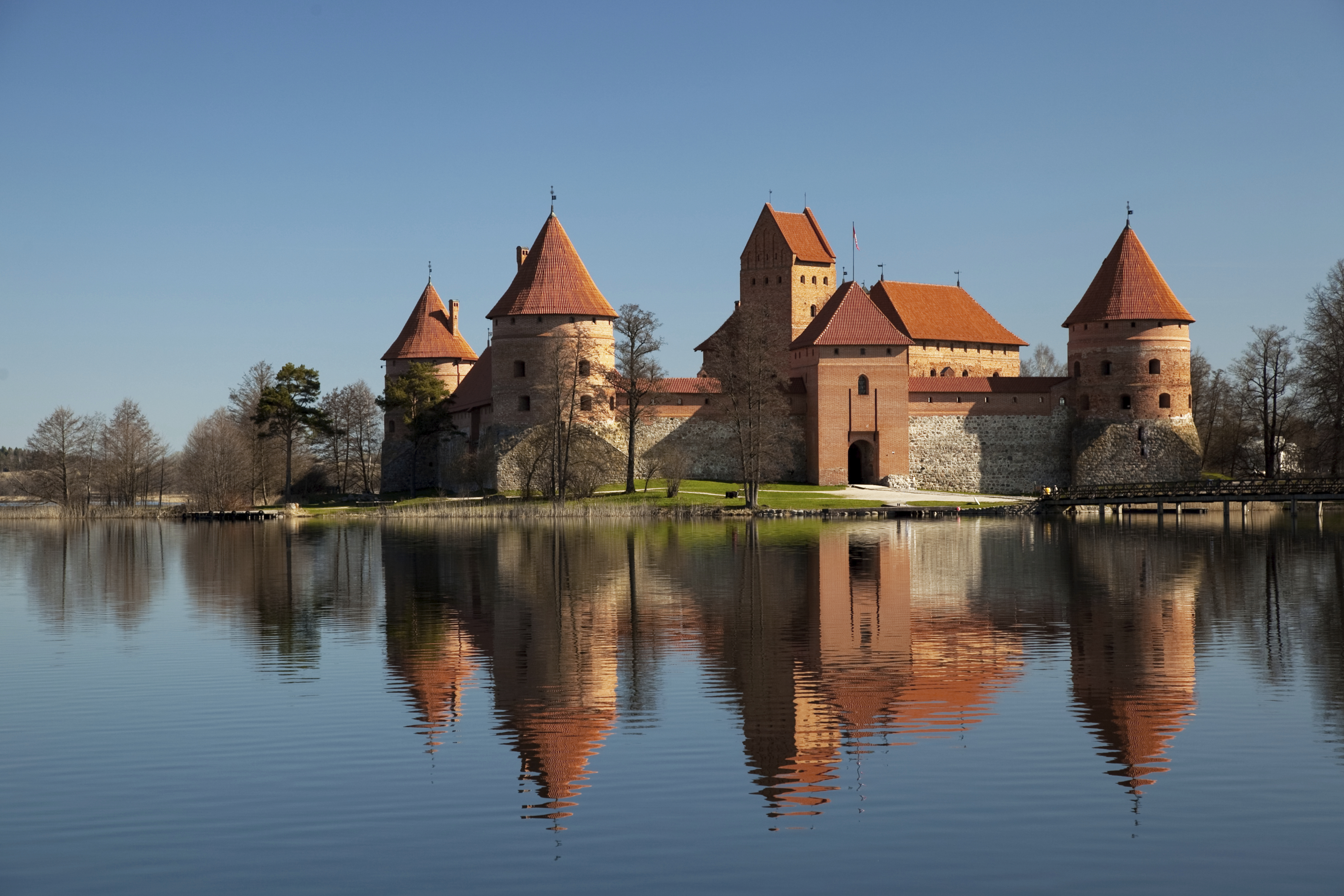Lithuania << lih thoo AY nee uh >> is a country on the Baltic Sea in northeastern Europe. Its name in Lithuanian, the official language, is Lietuvos Respublika (Republic of Lithuania). Vilnius is the capital and largest city.

The Lithuanian peoples united into a single nation in the late 1100’s. From the late 1300’s until the 1700’s, Lithuania was united with Poland. Russia ruled the country from the late 1700’s until 1918, when Lithuania declared independence. In 1940, the Soviet Union occupied Lithuania and forced it to become one of the 15 republics of the Soviet Union. Lithuania regained independence in 1991, the year the Soviet Union dissolved.
Government.
Lithuania is a republic. The president is the head of state and is elected by the people to a five-year term. The president appoints a prime minister with the approval of the parliament. A cabinet of ministers helps carry out the operations of government. Lithuania’s parliament has 141 members, who are elected by the people to four-year terms. All citizens age 18 or older may vote.

The Supreme Court is Lithuania’s highest court. Other courts include the Court of Appeal and the Constitutional Court.
People.
About 85 percent of the people of Lithuania are Lithuanians, a nationality group that has its own customs and language. Most of the rest of the people are Poles or Russians. Lithuania also has a small number of Belarusians and Ukrainians.
About 80 percent of the people of Lithuania are Roman Catholics. Most others belong to the Russian Orthodox Church or a Protestant denomination. The nation also has a small number of Jews. Lithuania’s culture developed under Roman Catholic influence, and Catholic traditions remain part of the people’s lives.
Most people live in urban areas and wear clothing like that worn elsewhere in Europe. But Lithuanians cherish their decorative national costumes and wear them on festive occasions.
For recreation, Lithuanians enjoy singing and sports, particularly basketball, boxing, rowing, and soccer. Choral singing is highly developed in Lithuania, and thousands of people sing and dance in annual festivals that attract huge crowds. Many folk tales and ancient Lithuanian songs, called dainos, have been handed down in spoken form for generations.
Children are required to attend school from the age of 6 to 16. Vilnius University is the oldest university. It was established in 1579.
Land and climate.
Most of Lithuania consists of flat or gently sloping land. The highest elevations are in the southeast. The land dips down to central lowlands and rises slightly in the west.
Lithuania, Latvia, and Estonia, which all border the Baltic, are often called the Baltic States. White sand dunes along Lithuania’s Baltic coast provide a popular resort area. The dunes are especially attractive on a long strip of land that separates a lagoon from the Baltic Sea.
Lithuania has about 3,000 small lakes and numerous rivers. The longest and largest river is the Neman (called Nemunas in Lithuanian). It begins in Belarus and drains most of Lithuania during its course to the Baltic. Forests cover about a fourth of the land.
In January, Lithuania’s coldest month, the temperature averages from about 25 to 31 °F (–3 to 0 °C). In July, the hottest month, temperatures average from about 64 to 69 °F (17 to 20 °C). The average annual precipitation ranges from 24 to 33 inches (61 to 84 centimeters).
Economy.
Service industries employ over half of Lithuania’s workers. Hotels, restaurants, and shops benefit from the growing number of tourists from Belarus, Germany, Poland, Russia, and other countries.
Manufacturing is also important to Lithuania’s economy. Lithuania manufactures chemicals, electronic products, furniture, machinery, processed foods, textiles, and wood products. It also has a large number of appliance factories. Kaunas, Klaipėda, Panevėžys, Šiauliai, and Vilnius are major industrial centers.
Agriculture employs many of Lithuania’s workers. Farm products include barley, beef, chickens, milk, pork, potatoes, sugar beets, and wheat.
The country mines clay, dolomite, limestone, and peat. Small quantities of oil have been discovered in western Lithuania and offshore in the Baltic Sea.
Lithuania’s imports and exports are closely related. It imports raw materials and exports finished products. Estonia, Germany, Latvia, Poland, Russia, and Sweden are among the country’s leading trade partners.
History.
People lived in the region that is now Lithuania in 8000 B.C. Groups that were the ancestors of the Lithuanian people lived there by about 2,000 years ago.
In the A.D. 100’s, the Roman historian Tacitus made the first historical mention of the people who lived near the Baltic Sea. He stated they sold amber to the Romans.
Early leaders.
Near the end of the 1100’s, the Lithuanian peoples united into a single nation. The first great ruler was Mindaugas, who became king in 1251. Mindaugas was assassinated by nobles in 1263.
In the 1200’s, the people fought a group of German crusaders called the Teutonic Knights, who tried to conquer Lithuania (see Teutonic Knights). Lithuania expanded its boundaries in the 1300’s. In time, it extended nearly to the city of Moscow in the east and to the Black Sea in the south. In 1386, Grand Duke Jogaila (Jagiello in Polish) united Lithuania with Poland. At first, this union was a confederation of two states ruled mostly by the same person. They were made a single state in 1569.

Russian rule.
The Lithuanian-Polish government collapsed in the 1700’s, and in 1795, Lithuania came under the rule of the czar of Russia. The people rebelled against Russian rule in 1831 and 1863 but failed to win independence. The czar tried to increase Russian influence in Lithuania. He prohibited books printed in Lithuanian and closed Lithuanian schools. But the people continued to educate their children and kept the national culture alive. Many Lithuanians emigrated to the United States during this period and also during later periods.
Independence.
The movement for an independent Lithuania became organized in the 1880’s. In 1905, a conference of elected representatives of Lithuania demanded self-government for their people within the Russian state. The Russians rejected this demand. During World War I (1914-1918), German troops occupied Lithuania. On Feb. 16, 1918, Lithuania became the first of the Baltic States to declare its independence from Russia and Germany. Lithuania established a democratic system of government in which the parliament had power over the president. A land-reform program broke up large estates and distributed land among the poor. The government also set up an educational system.
Fighting continued in Lithuania after World War I ended. Russia attempted to take over the country. The Lithuanians defeated Russia, and a peace treaty was signed in 1920. Poland occupied Vilnius from 1920 to 1939. In 1926, a group of military officers and civilian politicians seized power. Antanas Smetona became president. He gradually took over more of the authority that the president had shared with parliament.
In March 1939, Germany seized part of Lithuania. A combination of Lithuanian political parties tried to restore democracy but failed. Later in 1939, Germany and the Soviet Union agreed to divide much of eastern Europe between them. (The Soviet Union had been formed in 1922 under Russia’s leadership.) The agreements gave the Soviet Union control of the Baltic region. The Soviets then built some military bases in Lithuania.
Soviet republic.
In 1940, during World War II, the Soviet Union occupied all of Lithuania and made it a Soviet republic with a Communist government. After the Germans invaded the Soviet Union in 1941, the Lithuanians revolted against their Soviet rulers and established their own government. But the Germans suppressed the government. They conquered Lithuania and occupied it until 1944, when the Soviet Union again took it over.
Until the Soviet conquest, Lithuania was a rural society. About three-fourths of the people lived in small villages. The Soviet government ended the traditional Lithuanian style of life by industrializing the country. The government also took away private land and combined small farms into large state-owned farms. It built many factories, and large numbers of people moved from rural areas into cities to work in these factories.
The Soviets made the practice of many traditional Lithuanian customs difficult. For example, Soviet laws forbade religious instruction, religious publications, and charity work. People who attended church were kept from good educational and employment opportunities.
Resistance to Soviet rule.
From the time of the Soviet take-over in 1944 to 1952, Lithuanian guerrillas fought the Soviets. Thousands of guerrillas were killed in the fighting. The Soviet government sent about 350,000 Lithuanians to labor camps in Siberia for their political beliefs or as punishment for resisting Soviet rule.
In 1972, many Lithuanian students and young workers demonstrated against the Soviet government, and several people burned themselves to death in protest. Lithuanians continued to express opposition to Soviet rule, particularly after the mid-1980’s, when the leader of the Soviet Union, Mikhail Gorbachev, began calling for more openness in Soviet society.
In 1988, Lithuanian intellectuals set up Sajudis, a non-Communist movement to give Lithuania complete control of its economy, citizenship requirements, education, and cultural development. Sajudis sought to clean up rivers, lakes, and the Baltic Sea shores, all of which had been severely damaged by industrial pollution. Most members of this and similar movements sought total independence and separation from the Soviet Union. Lithuanians supported these goals by staging public demonstrations. They elected supporters of independence as representatives to the Soviet parliament that was created in 1989.
In 1989, Lithuania’s parliament expressed a commitment to full independence. It declared that laws adopted by the Soviet parliament were invalid in Lithuania unless approved by the Lithuanian parliament. The government declared Lithuanian the official language. Russian had been the official language under the Soviets. The government also allowed freedom of religion and the press.
On Dec. 7, 1989, the Lithuanian parliament abolished the monopoly of power that the Communist Party had held since 1940. It established a multiparty political system. Parliamentary elections were held in February 1990. A pro-independence coalition led by Sajudis won over 90 percent of the parliamentary seats.
On March 11, the new parliament declared an immediate restoration of Lithuania’s independence as a nation. The Soviet Union demanded a recall of the declaration, but the Lithuanians refused. In response, the Soviet Union applied economic pressure. It cut off all of its shipments of oil, medical supplies, and many other goods. In June—under pressure from Western nations—the Soviet Union and Lithuania held talks that led to an agreement. Under the agreement, the Soviets restored shipments of raw materials and other goods to Lithuania. In turn, the Lithuanians agreed to suspend their declaration of independence temporarily if negotiations with the Soviets took place. But in January 1991, Soviet forces moved into Lithuania to crack down on the freely elected government and the independence movement. Fourteen Lithuanians died, and more than 500 others were injured.
Independence regained.
In August 1991, several conservative Communist officials failed in an attempt to overthrow Gorbachev and take over the Soviet government. After the failed coup, Lithuania pressed the Soviet Union for recognition of its independence. In September, the Soviet government recognized Lithuania’s independence. In December, most of the republics formed a loose association called the Commonwealth of Independent States, and the Soviet Union was dissolved. Lithuania and the other Baltic States declined to join the association, however, because they feared that Russia would have too much influence over the group. The last Russian troops withdrew from Lithuania in 1993.
After achieving independence, Lithuania quickened the pace of economic reform, which had begun in the late 1980’s. The changes brought short-term economic hardship. In 1992, the economic problems helped cause the Sajudis coalition to lose control of parliament.
Recent developments.
By the mid-1990’s, many of Lithuania’s businesses had become privately owned, and much farmland was under private control. Lithuania sought to strengthen its ties to Europe. In 2004, it joined both the European Union (EU), which promotes economic and political cooperation, and the North Atlantic Treaty Organization (NATO), a defense alliance. In 2009, voters elected Dalia Grybauskaite as the country’s first woman president. She was reelected in 2014.
